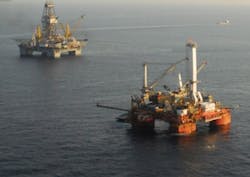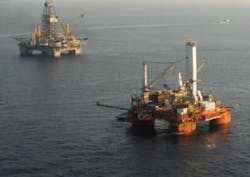BP reports static kill working on Macondo well in Gulf of Mexico
The Macondo well in the Gulf of Mexico on Aug. 4 was in a static condition, meaning the hydrostatic pressure of the drilling mud offset the reservoir pressure—the desired outcome of the static kill procedure that started Aug. 3.
BP PLC, operator of Macondo, pumped heavy drilling mud into the top of the well for about 8 hr starting at 3 p.m. CDT on Aug. 3. On Aug. 4, crews monitored the well to ensure it remained static. The well is on Mississippi Canyon Block 252 in 5,000 ft of water.
Kent Wells, BP senior vice-president of exploration and production, said a static condition means BP does not have to have a valve closed to contain the well. An Apr. 20 blowout of the Macondo well resulted in an explosion and fire on Transocean Ltd.'s semisubmersible drilling rig, killing 11 people.
"Further pumping of mud may or may not be required depending on results observed during monitoring," BP said on Aug. 4. The start of the static kill was based on the results of an injectivity test, which immediately preceded the static kill and lasted about 2 hr on Aug. 3.
Transocean Ltd.'s Development Driller III semisubmersible, drilling a relief well, and the Helix Q4000 participate in efforts to kill BP PLC's Macondo well about 40 miles off Louisiana. Photo taken on July 31 by US Coast Guard Petty Officer 1st Class Sara Francis. Photo from USCG.
The static kill was done to assist BP's strategy to kill the flow of oil and gas within Macondo, and the static kill is intended to complement the upcoming relief well operation to kill the flow from the bottom and to permanently seal the Macondo well with cement.
Wells said on Aug. 3 that the success of pumping heavy drilling fluid into the well during the static kill helped to provide information on how to best kill the Macondo well. BP and federal officials decided late Aug. 4 to cement the well in two ways: using the static kill and also using a relief well.
Relief well ready
Operations on the two relief wells were suspended during static kill operations. Depending upon weather conditions, Wells estimates sometime during Aug. 11-15 as the most likely date by which the first relief well will intercept the Macondo well annulus.
In a conference call on Aug. 3, National Incident Commander and retired US Coast Guard Adm. Thad Allen emphasized that the well will not truly be sealed until at least one relief well is finished.
Transocean's Development Driller III semisubmersible drilled the first well in which crews placed a cement shoe while awaiting completion of the static kill. When the relief well resumes drilling, crews will drill through the shoe, Allen said. Crews then have about 100 ft more to drill to intercept the Macondo well.
"They were offshoot about 4½ ft from the other wellbore right now," Allen said. "So, it will be going over 4 ft and down about 100 ft at an incline of about 2.9°."
More Oil & Gas Journal Current Issue Articles
More Oil & Gas Journal Archives Issue Articles
View Oil and Gas Articles on PennEnergy.com

